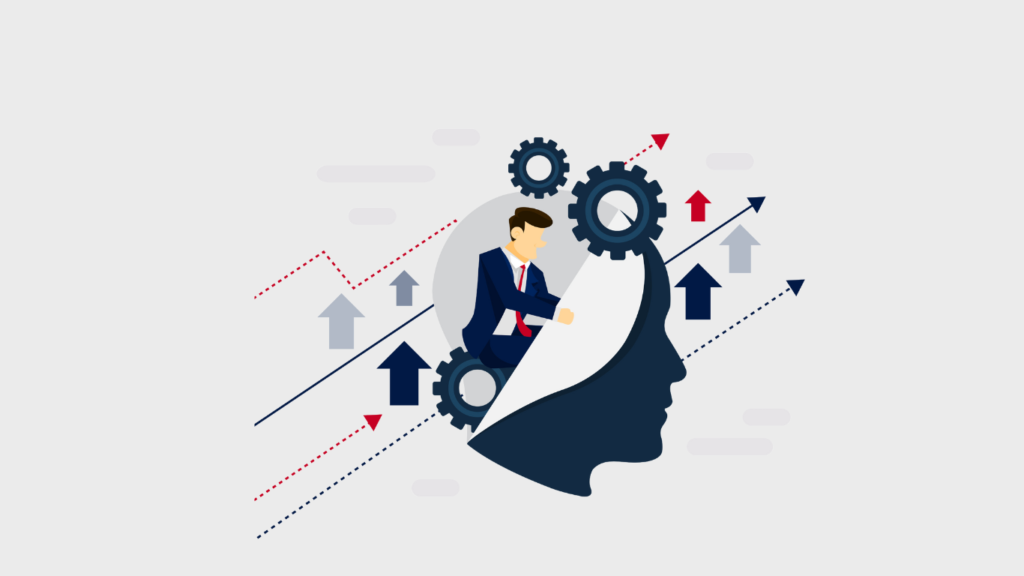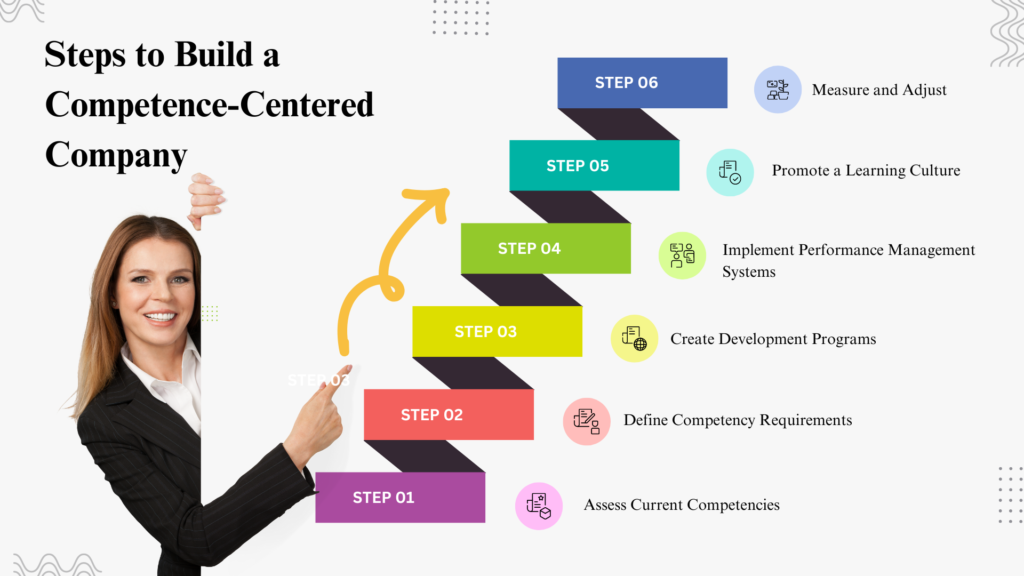In today’s fast-paced business landscape, companies must adapt quickly to remain competitive. A vital strategy for achieving this is to focus on building a competence-centered company. This approach prioritizes developing the skills, knowledge, and capabilities of employees, ensuring that the organization can innovate and thrive in a rapidly changing environment. This blog will guide you through the key elements and steps involved in creating a competence-centered company.
1. Understanding Competence-Centered Approach

A competence-centered company focuses on leveraging the skills and abilities of its workforce to achieve business goals. This approach aligns individual competencies with organizational objectives, creating a synergy that drives growth and innovation.
As Peter Drucker famously said, “The most valuable asset of a 21st-century institution, whether business or non-business, will be its knowledge workers and their productivity.”
2. Benefits of a Competence-Centered Company
Enhanced Employee Performance: By focusing on competence, employees can perform their tasks more efficiently and effectively. According to a Gallup report, companies that focus on employee strengths have 8% higher productivity and 14.9% lower turnover.
Increased Innovation: Competence development encourages creative thinking and problem-solving. A study by PwC found that 81% of CEOs are looking for a much broader range of skills than in the past, highlighting the need for continuous development.
Greater Agility: Skilled employees can adapt to changes and new challenges more quickly. Research by Deloitte shows that highly adaptable organizations are twice as likely to exceed their financial goals.
Improved Employee Engagement: Investment in employees’ growth fosters a culture of loyalty and motivation. According to LinkedIn’s 2023 Workplace Learning Report, 94% of employees say they would stay at a company longer if it invested in their career development.
3. Steps to Build a Competence-Centered Company

Building a competence-centered company involves a systematic approach to developing and leveraging employee skills and abilities. Here are detailed steps to guide you through the process:
Step 1: Assess Current Competencies
Conduct a Skills Inventory:
- Surveys and Assessments: Use surveys, self-assessments, and 360-degree feedback tools to gather data on the current competencies of your workforce.
- Performance Data: Analyze performance reviews and productivity metrics to identify strengths and weaknesses.
Identify Competency Gaps:
- Benchmarking: Compare your employees’ skills against industry standards and best practices.
- Future Needs Assessment: Consider the strategic goals of your company and identify the competencies required to achieve them. For instance, if your company plans to expand into new markets, language skills and cultural competence may be crucial.
Step 2: Define Competency Requirements
Develop a Competency Framework:
- Role-Specific Competencies: Outline the skills, knowledge, and behaviors required for each role within the organization. This should include both technical skills and soft skills such as communication, teamwork, and problem-solving.
- Core Competencies: Identify a set of core competencies that are essential for all employees, reflecting the company’s values and culture.
Align with Business Objectives:
Ensure that the competency framework aligns with the strategic goals and vision of the company. This alignment will ensure that the development efforts contribute directly to the company’s success.
Step 3: Create Development Programs
Design Targeted Training Programs:
- Workshops and Seminars: Organize in-house training sessions on specific skills.
- Online Courses: Leverage e-learning platforms like Coursera, Udemy, and LinkedIn Learning to provide flexible learning opportunities.
- Certification Programs: Encourage employees to pursue relevant certifications that enhance their skills and credibility.
Mentoring and Coaching:
- Mentorship Programs: Pair less experienced employees with seasoned mentors who can provide guidance and support.
- Coaching Sessions: Implement regular coaching sessions to help employees refine their skills and address specific challenges.
Job Rotation and Cross-Training:
- Job Rotation: Allow employees to rotate through different roles to gain a broader understanding of the business and develop a diverse skill set.
- Cross-Training: Provide opportunities for employees to learn different functions within the company, enhancing their flexibility and adaptability.
Step 4: Implement Performance Management Systems
Regular Performance Reviews:
- Quarterly or Bi-Annual Reviews: Conduct performance reviews at regular intervals to assess progress and provide feedback.
- Competency-Based Assessments: Use the competency framework to evaluate employee performance, focusing on both achievements and areas for improvement.
Set Development Goals:
- SMART Goals: Establish Specific, Measurable, Achievable, Relevant, and Time-bound goals for competency development.
- Personal Development Plans: Create individualized development plans that outline the steps employees need to take to improve their competencies.
Step 5: Promote a Learning Culture
Encourage Continuous Learning:
- Learning Resources: Provide access to a library of learning materials, including books, articles, and online courses.
- Learning Communities: Establish communities of practice where employees can share knowledge and learn from each other.
Recognize and Reward Development:
- Incentives for Learning: Offer incentives such as bonuses, promotions, or public recognition for employees who actively engage in learning and development.
- Career Advancement: Clearly communicate how competency development can lead to career progression within the company.
Step 6: Measure and Adjust
Monitor Progress:
- Feedback Mechanisms: Implement regular feedback mechanisms to track the effectiveness of development programs. This can include employee surveys, focus groups, and performance metrics.
- Learning Analytics: Use data analytics to measure the impact of training programs on performance and business outcomes.
Adjust and Improve:
- Continuous Improvement: Regularly review and refine development programs based on feedback and performance data.
- Adapt to Changes: Stay agile and be ready to adjust the competency framework and development initiatives in response to evolving business needs and market conditions.
4. Challenges and Solutions
Building a competence-centered company is not without its challenges. Here are some common obstacles along with practical solutions based on real use cases:

Challenge 1: Resistance to Change
Use Case: At ABC Tech, management faced significant resistance when introducing a new competency framework. Employees were comfortable with existing processes and skeptical about the changes.
Solution: Management addressed this by clearly communicating the benefits of the new framework. They involved employees in the development process, allowing them to voice their concerns and provide input. Additionally, they conducted workshops to demonstrate how the new competencies would enhance their career growth. By creating buy-in and demonstrating tangible benefits, resistance was significantly reduced.
Challenge 2: Limited Resources for Training
Use Case: A mid-sized manufacturing company, XYZ Manufacturing, struggled with budget constraints that limited their ability to provide extensive training programs.
Solution: XYZ Manufacturing leveraged cost-effective e-learning platforms and online courses to provide training. They also partnered with local educational institutions to offer discounted courses. Additionally, they implemented a peer-to-peer learning system, where employees could share knowledge and skills internally, reducing the need for external training resources.
Challenge 3: Difficulty in Measuring Competencies
Use Case: At LMN Services, HR had a hard time quantifying the impact of competency development on performance and business outcomes.
Solution: LMN Services introduced a comprehensive performance management system that included regular assessments and feedback loops. They utilized data analytics tools to track progress and correlate competency improvements with business metrics such as productivity, employee engagement, and customer satisfaction. By establishing clear metrics and using technology to track progress, they were able to measure the effectiveness of their competency development programs.
Challenge 4: Maintaining Engagement in Continuous Learning
Use Case: A financial services firm, QRS Finance, found that employees were initially enthusiastic about continuous learning, but engagement waned over time.
Solution: QRS Finance introduced gamification elements into their learning programs, such as leaderboards, badges, and rewards for completing courses. They also created personalized learning paths tailored to individual career goals and interests. Regularly celebrating learning achievements in company-wide meetings helped maintain a high level of engagement.
Challenge 5: Aligning Competencies with Rapidly Changing Business Needs

Use Case: At DEF Corp, the rapidly changing market dynamics required frequent updates to the competency framework, creating confusion among employees.
Solution: DEF Corp established a dedicated team responsible for continuously monitoring industry trends and updating the competency framework accordingly. They implemented agile processes to quickly communicate changes and provide relevant training. Regular town hall meetings and transparent communication ensured that employees were always aware of why changes were being made and how they would benefit.
Conclusion
Building a competence-centered company is a strategic approach that can lead to sustained competitive advantage. By focusing on developing the skills and abilities of your workforce, you can create an agile, innovative, and high-performing organization. Embrace this approach, and you’ll be well-positioned to navigate the challenges of today’s business environment and achieve long-term success. To further optimize your skillforce and ensure your company’s success, reach out to Zigtal, a one-stop shop for a skills-based organization.


